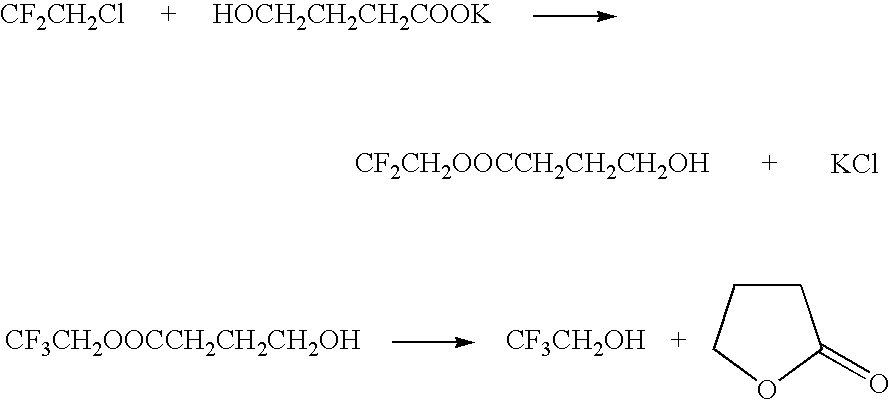Method for producing 2,2,2-trifluoroethanol
a technology of trifluoroethanol and trifluoroethanol, which is applied in the field of 2,2,2-trifluoroethanol, to achieve the effects of reducing the generation of edca, increasing the yield of 2,2,2-trifluoroethanol, and effectively removing/separating
- Summary
- Abstract
- Description
- Claims
- Application Information
AI Technical Summary
Benefits of technology
Problems solved by technology
Method used
Image
Examples
example 1
[0061]650 g (7.55 mol) γ-butyrolactone was placed in a 1000 ml flask equipped with a reduced pressure distillation apparatus, a thermometer, a stirrer, and a dropping funnel. 102 g of a 48% aqueous solution of potassium hydroxide (0.873 mol potassium hydroxide) was poured in the dropping funnel and was added dropwise approximately over 40 minutes while being stirred. The addition of the solution caused the reaction mixture to gradually generate heat and the internal temperature rose to approximately 50° C. The pressure of the system was reduced to 0.4 MPa and the reaction mixture was distilled for 12 hours to remove water while it was gradually heated to 145° C.
[0062]The resulting γ-butyrolactone solution contained 17.2 wt % potassium γ-hydroxybutyrate. A portion of this solution was neutralized with hydrochloric acid and was subjected to HPLC analysis. The results of the analysis indicated that no EDCA (4,4′-oxybis(butyric acid)) was generated. The water content of the γ-butyrolact...
example 2
[0063]Potassium γ-hydroxybutyrate was synthesized in the same manner as in Example 1, except that water was distilled out at 165° C. and the pressure of the system was reduced to 0.8 MPa.
[0064]The resulting γ-butyrolactone solution contained 17.0 wt % potassium γ-hydroxybutyrate. A portion of this solution was neutralized with hydrochloric acid and was subjected to HPLC analysis. The results of the analysis indicated that 0.2 wt % EDCA (4,4′-oxybis(butyric acid)) was generated. The water content of the γ-butyrolactone solution was analyzed by Karl Fischer technique and was determined to be 3.3 wt %.
example 3
[0065]Potassium γ-hydroxybutyrate was synthesized in the same manner as in Example 1, except that the distillation was continued for 18 hours.
[0066]The resulting γ-butyrolactone solution contained 16.6 wt % potassium γ-hydroxybutyrate. A portion of this solution was neutralized with hydrochloric acid and was subjected to HPLC analysis. The results of the analysis indicated that 0.8 wt % EDCA (4,4′-oxybis(butyric acid)) was generated. The water content of the γ-butyrolactone solution was analyzed by Karl Fischer technique and was determined to be 3.5 wt %.
PUM
| Property | Measurement | Unit |
|---|---|---|
| temperature | aaaaa | aaaaa |
| time | aaaaa | aaaaa |
| temperature | aaaaa | aaaaa |
Abstract
Description
Claims
Application Information
 Login to View More
Login to View More - R&D
- Intellectual Property
- Life Sciences
- Materials
- Tech Scout
- Unparalleled Data Quality
- Higher Quality Content
- 60% Fewer Hallucinations
Browse by: Latest US Patents, China's latest patents, Technical Efficacy Thesaurus, Application Domain, Technology Topic, Popular Technical Reports.
© 2025 PatSnap. All rights reserved.Legal|Privacy policy|Modern Slavery Act Transparency Statement|Sitemap|About US| Contact US: help@patsnap.com


